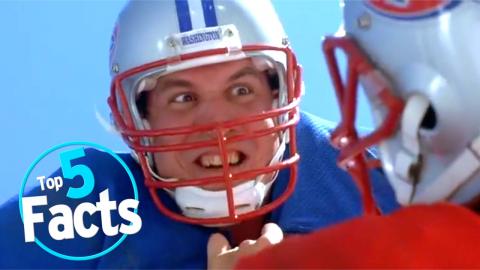Top 5 Concussion Facts

The word “concussion” is a generic term for traumatic brain injuries, but the specifics are startling. Welcome to WatchMojo's Top 5 Facts. In this instalment, we're counting down the most interesting facts that we could find about concussions.
Special thanks to our users hyprmania52 for submitting the idea using our interactive suggestion tool at http://www.WatchMojo.comsuggest
Top 5 Facts about Concussions
The word “concussion” is a generic term for traumatic brain injuries, but the specifics are startling. Welcome to WatchMojo’s Top 5 Facts. In this installment, we’re counting down the most interesting facts that we could find about concussions.
#5: The NFL Pays for its History of Concussions
Big players, big hits, big paychecks. Concussions are part of the National Football League experience. But repeated concussions can lead to more than just a halo of stars and tweeting birds. Chronic traumatic encephalopathy, or CTE, is a progressive degenerative brain disease whose symptoms include depression, dementia, and suicidal ideation. Unfortunately, it can only currently be diagnosed after death. There’s a long list of professional athletes, particularly former NFL players, who have met untimely deaths due to CTE. Among them former NFL players Junior Seau, Jovan Belcher, and Andre Waters, and BMX icon Dave Mirra, all of whom killed themselves. But in 2013, thousands of retired players sued the NFL, alleging that the league withheld information concussion-related health problems. In 2015 a judge approved a $1 billion settlement, allowing for up to five million dollars in compensation for each of them. Yet there’s one major caveat: the settlement doesn’t cover future cases of CTE.
#4: Every Concussion Is Different
The human brain is extremely complex, and so no two brain injuries are ever the same. As The New York Times reported in 2011, two Major League baseball players experienced significantly different results after separate blows to the head. In the case of Justin Morneau, his recovery was more tedious given a previous baseball-related concussion and his history playing youth hockey. And for Josh Beckett? Well, he was back to business within days. Everyone reacts differently, and stress plays a factor as well. In the sporting world, this can be a difficult factor to manage when huge contracts, and indeed an athlete’s livelihood are at stake. But since each concussion is different, there is no cookie cutter treatment plan. In fact, even some basics have been called into question.
#3: The Best Thing To Do Is Rest... Or Is It?
The most common recommendation when recovering from a traumatic brain injury is to rest. That often goes beyond just Netflix and chilling to something called brain rest. So the most logical conclusion is that anyone dealing with a blow to the head should not be doing any physical activity until all symptoms subside. Well, not so fast. A 2016 study of over 3000 concussed children revealed that youths who exercise within the first seven days of a concussion experience half the symptoms that typically endure beyond the first month. So what is a TBI patient to do? Well, even though this isn’t the first study to show similar results, the authors caution that more research is needed. But kids should definitely not put themselves into a position where they can get injured again– low impact exercise like swimming or light aerobics might do the trick.
#2: Modern Sports Helmets Don’t “Prevent” Concussions
In the sporting world, talk is cheap, and protective helmets can be expensive. But the innovations of modern helmets don’t prevent concussions, but rather protect from bone fractures and internal bleeding. In fact, “concussion-proof helmets” simply don’t exist, as noted in a 2016 article by The Atlantic. No helmet is going to stop your brain from sloshing around inside your skull. The Atlantic article even compared a concussion to shaking an egg; the shell, or skull, is protected by helmets, but the yolk, or brain, still gets scrambled. Believe it or not, concussions still happen without direct contact to the head. And there’s simply little evidence that new designs can minimize the chances of being concussed. Of course, if you’re a fan of not splitting your skull open, wearing a helmet is still a good choice.
#1: Concussions Increase the Risk of Depression and Suicide
After a concussion, the risk of suicide is three times higher for adults. One may not experience such feelings right away, but a 2016 study published in the Canadian Medical Association Journal shows how mental illness develops after a traumatic brain injury. It’s a dark truth, but an important one, and even more so for teens. Just as concussed adults are more prone to suicide, concussed teens are three times more likely to experience depression than their peers. Incidentally, the symptoms of depression can easily mask the symptoms of the concussion itself. Once again, everybody reacts differently. And though we can’t predict how symptoms may develop, we can look at the facts to better understand the long-term effects of concussions.
So, do you think the NFL does enough to protect their players’ health? And how do you think new studies will affect modern sports? For more investigative top 10s and hard-hitting Top 5s, be sure to subscribe to WatchMojo.com.
